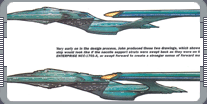
Probert's next-to-last project in Hollywood proved to be the one for which he is most well known. Most of it was slightly altered – some of it beyond what I felt comfortable with – but nonetheless still recognizable with the original concepts." ( Enterprise Incidents, issue 17, p. I'd say about 70% of what I came up with was used. For the movie he further re-designed the orbital office complex, drydock, and Travel Pod, adding the Work Bee and Vulcan Shuttle.ĭue to the fact that Probert was retained by EEG to continue working on the movie, unlike many other former ASTRA employees, he ultimately ended up working a year and a half on the project, pleased that most of his efforts was not in vain, " Well, I think I really lucked out in a way. Brought in by his Art Director Richard Taylor in early 1978, Probert went on re- designing this version, plus he designed several of the Enterprise's interiors, as well as those for the K't'inga-class. When Star Trek: Phase II (the proposed successor of Star Trek: The Original Series) was canceled, in order to produce The Motion Picture, original Enterprise designer, Matt Jefferies, elaborated upon by Art Director Joe Jennings, had already come up with their version of an upgraded Enterprise, and a studio model was in the process of being constructed.

%2C_ENT1231.jpg)
Probert ( born 5 September 1946 age 75) has an artistic career that spans over twenty years, ten of which were spent working on some of science-fiction fans' favorite Hollywood productions, including two from the Star Trek franchise, which were:Īfter having served on the original 1978 television production Battlestar Galactica, Probert moved over to the big screen as a major contributor on Star Trek: Phase II's successor, Star Trek: The Motion Picture, Recommended for the position on the project by Ralph McQuarrie, Probert was employed at Robert Abel & Associates's subsidiary art department company, Astra Image Corporation, starting on 1 April 1978 as concept designer/production illustrator, providing designs for all of the humanoid spacecraft in the film, moving over to Entertainment Effects Group (EEG) in the same capacity, after the former was pulled from the project. Starting out in Star Trek fandom, Andrew "Andy" G.


 0 kommentar(er)
0 kommentar(er)
